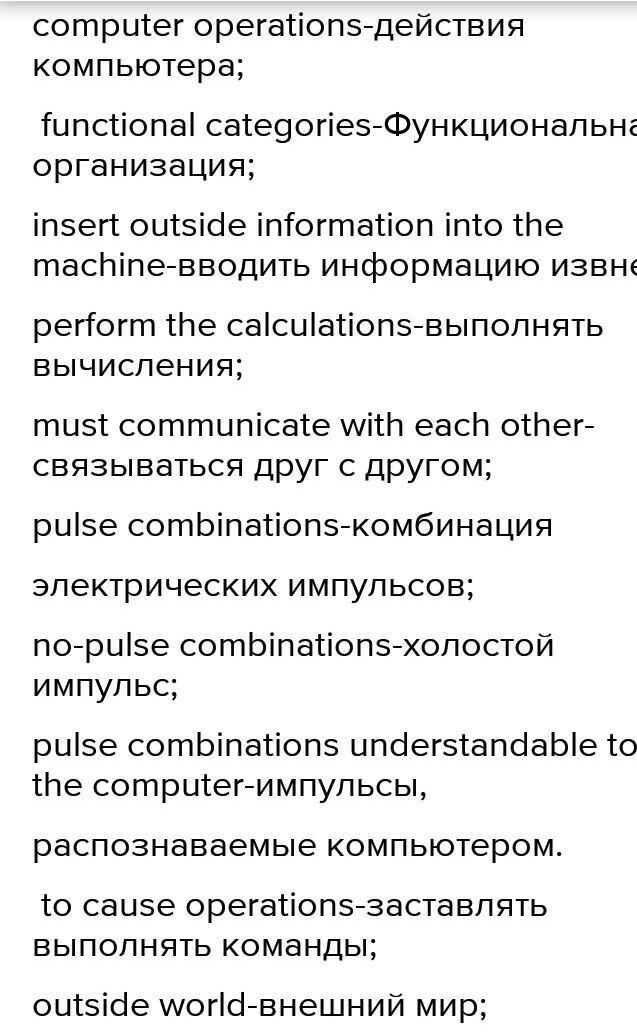Предмет: Английский язык,
автор: avyoldyladvllzhs43
Задания английский!
As we know, all computer operations can be grouped into five functional categories. The method
in which these five functional categories are related to one another represents the functional
organization of a digital computer. By studying the functional organization, a broad view of the
computer is received.
The five major functional units of a digital computer are:
1) Input— to insert outside information into the machine;
2) Storage or memory – to store information and make it available at the appropriate time;
3) Arithmetic-logical unit – to perform the calculations;
4) Output – to remove data from the machine to the outside world and;
5) Control unit – to cause all parts of a computer to act as a team.
A complete set of instructions and data are usually fed through the input equipment to the memory
where they are stored. Each instruction is then fed to the control unit. The control unit interprets
the instructions and issues commands to the other functional units to cause operations to be
performed on the data. Arithmetic operations are performed in the arithmetic-logical unit, and the
results are then fed back to the memory. Information may be fed from either the arithmetic unit or
the memory through the output equipment to the outside world. The five units of the computer
must communicate with each other. They can do this by means of a machine language which uses
a code composed of combinations of electric pulses. These pulse combinations are usually
represented by zeros and ones, where the one may be a pulse and the zero – a no-pulse. Numbers
are communicated between one unit and another by means of these one-zero or pulse – no-pulse
combinations. The input has the additional job of converting the information fed in by the operator
into machine language. In other words, it translates from our language into the pulse – no-pulse
combinations understandable to the computer. The output’s additional job is converting the pulse
– no-pulse combinations into a form understandable to us, such as a printed report.
1. Просмотрите текст еще раз. Дайте ответы на вопросы, используя информацию
текста
1. What represents the functional organization of a computer? 2. What can we get by
studying the functional organization? 3. What is the function of the input device? 4. What
does memory serve for? 5. What is the task of the arithmetic-logical unit?6. What is the
function of the output? 7. What is the main purpose of the control unit? 8. How do all units
of the computer communicate with each other? 9. What is the additional job of the input?
10. What is the additional function of the output?
2. Найдите в тексте английские эквиваленты следующих словосочетаний
Функциональная организация; действия компьютера; связывать друг с другом;
вводить информацию извне; делать информацию доступной; выполнять вычисления;
выводить информацию; блок управления; выдавать команды; заставлять выполнять
команды; выходное устройство; внешний мир; связываться друг с другом;
комбинация электрических импульсов; холостой импульс; импульсы,
распознаваемые компьютером.
3. Вспомните значение следующих прилагательных и преобразуйте их в
сравнительную и превосходную степени
1 - Small; fast; new; long; late; wide; young; easy; great; dull; rich; bulky; large; vast;
early; old; broad.
2 - Frequent; reliable; approximate; significant; intricate; possible; basic; remarkable;
common; modern; dependent; general; necessary; successful; scientific; universal.
3 - Good; bad; little; many.
Ответы
Автор ответа:
1
Ответ:
Вот Вот вот Вот Вот Вот Вот Вот Вот Вот Вот Вот Вот
Приложения:

Похожие вопросы
Предмет: Биология,
автор: vasy8
Предмет: Английский язык,
автор: alinka676
Предмет: Физика,
автор: AlonZe88
Предмет: Химия,
автор: alinochka12012003